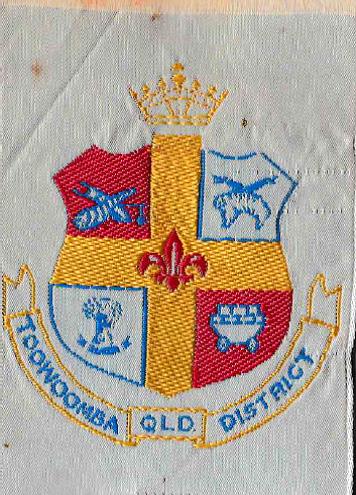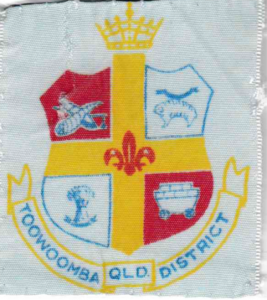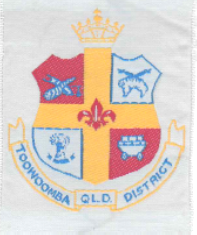
Toowoomba District (Ext)
Locations
City of Toowoomba and surrounding Darling Downs areas.
Maps
Badge Description
When the Scout Association applied to use the current Coat of Arms of Towoomba, it was rejected. However, they were given permission to use the older Coat of Arms from 1900 [8].
Scout logo
Crown of Queen Elizabeth II, Shield & Cross = Coat of Arms
Haystack = Grazing and cereal-growing on the fertile surrounding the Darling Downs
Fleece = Wealth created by the wool and sheep farming industry
Bricks in barrow = symbolises the manufacturing in industry in Toowoomba in the 1970-80s, and by 1983, 40% of Queensland’s flour trade and bread market was produced in Toowoomba
Plough & agricultural equipment = Toowoomba’s manufacturing produced farm equipment such as troughs, wool presses and wagons and diversified into wind pumps, steam engines and locomotives.
Previous Badge Variations
The following are variations of the badge:
 |
 |
|
Type : Silk screened printed |
Type : Ribbon |
|
50 x 56 mm |
52 x 60 mm |
|
Ext |
Ext |
History
Toowoomba district’s name is made up of the aboriginal interpretation for “reeds in the swamp” (i.e., Woomba Woomba) [1]. that the word Toowoomba and the aboriginal term for a native melon “Toowoom” or “Choowoom” which grew plentifully in the area. The district encompassed a broad area within Darling Down’s gerographical region.
In 1910, Toowoomba youth met to form the first scout patrols, and eventually become the 1st Toowoomba Scout Group [2]. Toowomba District was first formed in 1937, with Hugh Falconer as the first District Commissioner. In 1959, Towoomba District was broken up into East Toowoomba District and also a West Toowoomba District. East Toowoomba District and West Toowoomba District were separated by Ruthven St. The two district were re-amalgamated to form a single Toowoomba District in November 1957 [3]. In 1945, Toowoomba became the Headquarters for South and South West County. The County included areas covering the New South Wales border to North of Toowoomba, and from Gatton, below the Toowoomba Range, in the east stretching to Charleville, Cunnamulla and beyond in the West [4]. In 1966, Toowoomba District was renamed the Darling Downs Area. Ron Blomely was appointed the first Area Commissioner. [5]
Groups
East Toowoomba District Groups (1950): 1st, 3rd, 4th, 5th, 7th, 8th and 10th Toowoomba Scout Group [6]
West Toowoomba District Groups (1950): 2nd, 6th and 9th Toowoomba Scout Group, Drayton Scout Group , Newtown Scout Group , Oakey Scout Group, Pittsworth Scout Group. [7]
Toowoomba District Groups (1950): made up of groups within both East and West Toowoomba Districts.
References
- The derivation of the name Toowoomba is ambiguous, though the most widely accepted theory is that it’s more or less a pronunciation of the Aboriginal word for ‘The Swamp’. (30/10/2018) Retrieved from: https://www.toowoomba.org/about-toowoomba.html
- Madden, J. (2012). Scouting yarn of the Darling Downs: A history. Clifford Gardens, Queensland: The Scout Association of Australia, Queensland Branch Inc., Darling Downs Region. p. 15.
- Madden, 2012, Scouting Yarns of the Darling Downs. p. 37, 81, 95.
- Madden, J. (2012). Scouting yarn of the Darling Downs: A history. Clifford Gardens, Queensland: The Scout Association of Australia, Queensland Branch Inc., Darling Downs Region. p. 54.
- Madden, J. (2012). Scouting yarn of the Darling Downs: A history. Clifford Gardens, Queensland: The Scout Association of Australia, Queensland Branch Inc., Darling Downs Region. p. 95, 109.
- Madden, J. (2012). Scouting yarn of the Darling Downs: A history. Clifford Gardens, Queensland: The Scout Association of Australia, Queensland Branch Inc., Darling Downs Region. p. 81.
- Madden, J. (2012). Scouting yarn of the Darling Downs: A history. Clifford Gardens, Queensland: The Scout Association of Australia, Queensland Branch Inc., Darling Downs Region. p. 81.
- Haskard, D. (1983). The complete book of Australian Scout badges: Part 2, Queensland and Papua New Guinea. Chatswood, NSW: Badgophilist Publications. p.25.
